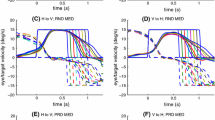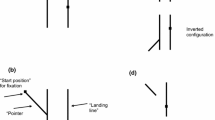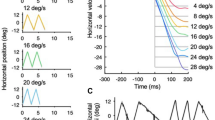Abstract
It is well known that prediction is used to overcome processing delays within the motor system and ocular control is no exception. Motion extrapolation is one mechanism that can be used to overcome the visual processing delay. Expectations based on previous experience or cognitive cues are also capable of overcoming this delay. The present experiment was designed to examine how smooth pursuit is altered by cognitive information about the time and/or direction of an upcoming change in target direction. Subjects visually tracked a cursor as it moved at a constant velocity on a computer screen. The target initially moved from left to right and then abruptly reversed horizontal direction and traveled along one of seven possible oblique paths. In half of the trials, a cue was present throughout the trial to signal the position (as well as the time), and/or the direction of the upcoming change. Whenever a position cue (which will be referred to as a timing cue throughout the paper) was present, there were clear anticipatory adjustments to the horizontal velocity component of smooth pursuit. In the presence of a timing cue, a directional cue also led to anticipatory adjustments in the vertical velocity, and hence the direction of smooth pursuit. However, without the timing cue, a directional cue alone produced no anticipation. Thus, in this task, a cognitive spatial cue about the new direction could not be used unless it was made explicit in the time domain.








Similar content being viewed by others
References
Badler J, Lefevre P, Missal M (2010) Causality attribution biases oculomotor responses. J Neurosci 30:10517–10525
Barnes GR, Barnes DM, Chakraborti SR (2000) Ocular pursuit responses to repeated, single-cycle sinusoids reveal behavior compatible with predictive pursuit. J Neurophysiol 84:2340–2355
Bennett SJ, Barnes GR (2003) Human ocular pursuit during the transient disappearance of a visual target. J Neurophysiol 90:2504–2520
Bennett SJ, Barnes GR (2004) Predictive smooth ocular pursuit during the transient disappearance of a visual target. J Neurophysiol 92:578–590
Burke MR, Barnes GR (2008) Anticipatory eye movements evoked after active following versus passive observation of a predictable motion stimulus. Brain Res 1245:74–81
Carl JR, Gellman RS (1987) Human smooth pursuit: stimulus-dependent responses. J Neurophysiol 57:1446–1463
Collewijn H, Tamminga EP (1984) Human smooth and saccadic eye movements during voluntary pursuit of different target motions on different backgrounds. J Physiol 351:217–250
Engel KC, Soechting JF (2003) Interactions between ocular motor and manual responses during two-dimensional tracking. Prog Brain Res 142:141–153
Engel KC, Anderson JH, Soechting JF (1999) Oculomotor tracking in two dimensions. J Neurophysiol 81:1597–1602
Jarrett CB, Barnes G (2001) Volitional selection of direction in the generation of anticipatory ocular smooth pursuit in humans. Neurosci Lett 312:25–28
Jarrett CB, Barnes G (2002) Volitional scaling of anticipatory ocular pursuit velocity using precues. Brain Res Cogn Brain Res 14:383–388
Kao GW, Morrow MJ (1994) The relationship of anticipatory smooth eye movement to smooth pursuit initiation. Vision Res 34:3027–3036
Kettner RE, Leung HC, Peterson BW (1996) Predictive smooth pursuit of complex two-dimensional trajectories in monkey: component interactions. Exp Brain Res 108:221–235
Kowler E (1989) Cognitive expectations, not habits, control anticipatory smooth oculomotor pursuit. Vision Res 29:1049–1057
Kowler E, Steinman RM (1979a) The effect of expectations on slow oculomotor control. I. Periodic target steps. Vision Res 19:619–632
Kowler E, Steinman RM (1979b) The effect of expectations on slow oculomotor control. II. Single target displacements. Vision Res 19:633–646
Kowler E, Steinman RM (1981) The effect of expectations on slow oculomotor control-III. Guessing unpredictable target displacements. Vision Res 21:191–203
Ladda J, Eggert T, Glasauer S, Straube A (2007) Velocity scaling of cue-induced smooth pursuit acceleration obeys constraints of natural motion. Exp Brain Res 182:343–356
Leigh R, Zee D (1991) The neurology of eye movements. F.A. Davis Company, Philadelphia
Mrotek LA, Soechting JF (2007) Predicting curvilinear target motion through an occlusion. Exp Brain Res 178:99–114
Robinson DA (1965) The mechanics of human smooth pursuit eye movement. J Physiol 180:569–591
Soechting JF, Mrotek LA, Flanders M (2005) Smooth pursuit tracking of an abrupt change in target direction: vector superposition of discrete responses. Exp Brain Res 160:245–258
Soechting JF, Rao HM, Juveli JZ (2010) Incorporating prediction in models for two-dimensional smooth pursuit. PLoS ONE 5(9):e12574
Westheimer G (1954) Eye movement responses to a horizontally moving visual stimulus. AMA Arch Ophthalmol 52:932–941
Zago M, McIntyre J, Senot P, Lacquaniti F (2009) Visuo-motor coordination and internal models for object interception. Exp Brain Res 192:571–604
Acknowledgments
This work was supported by a United States Public Health Service Grant NS-15018. We thank Dr. Martha Flanders for helpful comments on this work.
Author information
Authors and Affiliations
Corresponding author
Rights and permissions
About this article
Cite this article
Winges, S.A., Soechting, J.F. Spatial and temporal aspects of cognitive influences on smooth pursuit. Exp Brain Res 211, 27–36 (2011). https://doi.org/10.1007/s00221-011-2638-7
Received:
Accepted:
Published:
Issue Date:
DOI: https://doi.org/10.1007/s00221-011-2638-7




